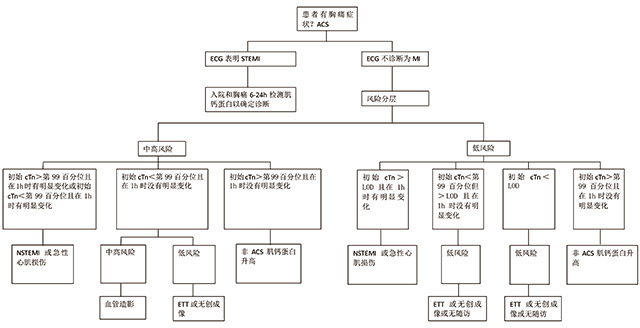高敏肌钙蛋白检测: 实验室和临床医生面临的挑战和机遇
实验室在急性和慢性心血管疾病管理中扮演的角色已经发生了变化。当前心肌标志物是进行急性心脏疾病诊断和管理的核心。心肌肌钙蛋白的检测,心肌肌钙蛋白T(cTnT)和心肌肌钙蛋白I(cTnI)已整合进急性心肌梗死(acute myocardial infarction,AMI)的再定义[1]和定义[2]中,欧洲心脏病学会(European Society of Cardiology,ESC)也将其视为疑似急性非ST段抬高心肌梗死(non-ST elevation myocardial Infarction,NSTEMI)管理的核心[3]。
早期例证中最终诊断排除AMI和推定诊断为不稳定型心绞痛的病人中约1/3存在可检测的肌钙蛋白,而该可检测的肌钙蛋白与不良预后相关,这是cTnT和cTnI检测转变的基础[4,5]。心肌肌钙蛋白检测在诊断和预后上有明显优势,但比心肌酶学检查昂贵(通常贵10~50倍)。为了弥补检测成本,肌钙蛋白检测被认为是心脏科和急诊科的“黄金门票”。心肌肌钙蛋白具有心肌特异性,因此可以可靠地诊断AMI,并且只需要在胸痛发作/入院10~12h检测一次。肌钙蛋白检测很受欢迎,但有些人认为这样一来忽略了临床医生的判断。正常健康个体中无法检测到肌钙蛋白,这时肌钙蛋白检测相对不那么敏感,现已优化决定限以等效基于WHO对AMI的原始标准的诊断。因此,从这个方面上肌钙蛋白的声明得到了调整,肌钙蛋白时代到来了。虽然主流观点是肾衰竭时肌钙蛋白会升高,但仍然存在关于检测间相对差异的争论。肾衰竭时cTnT和cTnI会升高,这是不可忽视的[6]。而被忽视的是心脏死亡尤其是心源性猝死,是肾衰竭患者最常见的死亡原因[7]。
肌钙蛋白的原始检测方法经过逐步地发展和改进而成为当前的高敏(high-sensitivity,hs)检测。hs检测不是检测肌钙蛋白的新形式。高敏肌钙蛋白的定义是在参考人群中第99百分位值处的变异系数(CV)低于10%且低于第99百分位值的检出率超过50%[8]。提高分析性能的趋动力一部分来自于厂商希望提高分析性能,更重要的则是心肌梗死进行了重新定义。原始的再定义文件规定将第99百分位值作为决定限并建议第99百分位值处的变异系数(CV)≤10%[1]。只有通用定义明确地定义肌钙蛋白升高或降低(增量变化)[2]。检测灵敏度的提高也扩大了临床条件范围,在无AMI的患者中检测到肌钙蛋白升高。正如急诊医生鲍勃杰西所说“当肌钙蛋白具有很差的检测性能时它是很有用的试验,但现在它具有很好的检测性能,而其是很差的试验”[9]。
然而,必须记住的是不论病因是什么,肌钙蛋白升高是预后性指标。有明确病理诊断的急性情况中如肺栓塞,肌钙蛋白升高的患者预后不良[10]。相同地,在急症重症监护下,肌钙蛋白升高也与预后不良相关[11,12]。慢性疾病也是这样,心脏衰竭[13,14]或肾功能损害[15,16]的患者肌钙蛋白升高也与长期预后不良相关。人群研究中,肌钙蛋白升高超过第99百分位值与亚临床疾病相关[17,18],并且有更高的长期风险[19-21]。有一种看法认为肌钙蛋白转换成hs检测发现了更多肌钙蛋白升高的患者,但这种升高可能并没有临床意义。当前已经表明降低诊断阈值能更好地识别具有重大风险的患者,使其从治疗中受益[22,23],同时诊断为MI的患者数量没有明显增加[24]。高敏肌钙蛋白检测提高了女性AMI的检出率[25]。此外,经常被忽略的一点是多数出现胸痛的患者其肌钙蛋白测量值在参考区间内。肌钙蛋白在第99百分位值内表明预后良好;而肌钙蛋白超过第99百分位值表明患者有潜在疾病。可能未必是AMI,但仍然需要对其进行适当的评估。
一、使用敏感和高敏肌钙蛋白检测对
胸痛患者进行鉴别诊断的策略
使用敏感和高敏肌钙蛋白检测对胸痛患者进行鉴别诊断的策略可以分为3类:基于第99百分位的策略、利用改进的分析不精密度的策略和基于新决定阈值的策略。
1.传统的第99百分位策略
这是一个大部分临床医生和实验室熟悉的概念,并且已经整合进MI的再定义和通用定义中。英国国家卫生和医疗卓越研究所(National Institute for Health and Care Excellence,NICE)原先推荐入院/胸痛发作10-12h测一次肌钙蛋白,反应了经济和分析性能要求。后来指南推荐入院和胸痛6-9h测量。最初的出版物使用敏感肌钙蛋白的检测,显示敏感肌钙蛋白对入院患者有良好的诊断准确度(受试者工作曲线下面积为0.96),且检测性能不受采样时间约束[27,28]。然而此处有警告。在当时诊断不与作为参考标准的高敏检测或第99百分位值的传统检测相比较,且样本组包含了有ST段抬高MI的患者。使用入院和胸痛3h样本是由ESC首先推荐的,后来,遵从NICE的证据和成本效益评估[30]。此处也有警告。在以高敏肌钙蛋白作为参考诊断一部分的一项研究中表明在一个大型前瞻性观察系列中对于最终诊断为MI有100%灵敏度的只有在症状发作8h内才能实现(通常是入院6h)[31]。NICE的评估不仅关注诊断准确度,也将成本效益考虑在内。因此既然应该应用3h诊断策略,那么它也应作为适当临床评估的一部分。对于某些患者,即使其3h肌钙蛋白值”正常”,可能也需要进行进一步检测或住院。
2.改进的第99百分位策略
澳大利来急诊医学会对此做过积极的调查。他们发现由结构化临床评估正式确定的低风险组和使用风险评分工具再结合入院和胸痛2h肌钙蛋白检测可以快速排除MI[32-36]。这里强调的不仅仅是MI的诊断,还要识别出未来心脏事件风险较低的人群,他们能顺利出院且在30天内不会重新入院。因此该策略不能保证100%检出所有AMI患者,但能识别会重新入院的患者。使用这种策略时,若使用的是高敏肌钙蛋白检测而不是传统的敏感检测,则该队列会延伸到具有相同诊断效率的高风险人群[37]。使用2h肌钙蛋白增量变化进一步深入研究表明结合2h肌钙蛋白增量变化和第99百分位值可得到对该人群的最佳诊断性能[38]。
3.利用改进的分析不精密度的策略
该策略是以结合使用有决定阈值的肌钙蛋白增量变化,通常位于第99百分位附近,从而有能力确定或排除急性心肌损伤为基础的。患者根据入院时和1h后肌钙蛋白的检测值再结合1h肌钙蛋白增量变化值而分成这3类。对于肌钙蛋白低于第99百分位或决定限且没有增量变化的患者可排除AMI。对于有一个值超过限值且有增量变化的划入AMI,对于没有超过限值且有显著增量变化或有超过限值但没有增量变化的划入中介范畴,需要进一步调查。使用决定限为12ng/L的肌钙蛋白T和增量变化为3ng/L进行诊断的初始研究声称其灵敏度和阴性预测值为100%。之后一项多中心研究证实这些发现虽然有较低的灵敏度[40],但已经有高敏cTnI的类似研究[41]。这些研究结果具有广泛的应用潜力,并且已经纳入ESC指南中[42]。事实上,虽然关注点集中在AMI上,但是规则划入和划出的是急性心肌损伤而不是AMI,还需要进一步的验证。
4.心肌肌钙蛋白的新决定阈值
上述策略是传统的,基于通用定义,目的在于诊断。而新决定阈值是以在短期随访中(通常是30天)用肌钙蛋白水平预测心脏事件风险的能力为基础,因此用于预后而非诊断。其目的是定义一个肌钙蛋白低值,通常位于该检测的决定限处或其附近,从而在第一次入院时排除临床显著心肌损伤,因此在第一次入院时取样检测一次。该法对高敏cTnT[43,44]和 cTnI[45]都是有效的,其灵敏度分别为99.8%[43]和99.9%[45],但必须记住该策略有一定的误诊率且其灵敏度达不到100%。此外,该策略对于早期发作的患者不太有效(梗死发作后不到2h),而且必须结合风险分层和临床判断。
二、高敏检测用于慢性疾病管理
高敏肌钙蛋白检测可以提供健康人群和患有慢性疾病人群的预后信息,这一点有据可查,如前所述,应支持使用肌钙蛋白对急性胸痛患者做出诊断决策。那么肌钙蛋白检测是否能用于监控治疗效果。当前对于心血管疾病一级预防的风险评估工具性能较差,有证据表明增加高敏cTn检测可以改善风险分层[46,47]。在一项随机对照试验中,一组使用普伐他汀的样本组分析显示位于基线处的肌钙蛋白值(用高敏cTnI法检测)可以在随访时预测心脏事件的风险[48]。此外,在随机治疗组中,cTnI降低时与那些cTnI升高的相比其风险是降低的。有肾脏疾病的患者,透析降低了肌钙蛋白的升高[49]。这些都是观察性研究,还需要进行干预性试验,因为观察或风险预测不能转化成有效的干预,但其结果很有趣。
总之,对于有胸痛症状或怀疑AMI的患者,高敏肌钙蛋白检测提供了改善患者分流的显著可能性。基于当前证据的诊断规则见图1。

参考文献
1. Myocardial infarction redefined–a consensus document of The Joint European Society of Cardiology/American College of Cardiology Committee for the redefinition of myocardial infarction. Eur Heart J 2000; 21: 1502–1513.
2. Thygesen K, Alpert JS, White HD, et al. Universal definition of myocardial infarction. Circulation 2007; 116: 2634–2653.
3. Bassand JP, Hamm CW, Ardissino D, et al. Guidelines for the diagnosis and treatment of non-ST-segment elevation acute coronary synDr.omes. The task force for the diagnosis and treatment of non-st-segment elevation acute coronary synDr.omes of the European Society of cardiology. Eur Heart J 2007; 28: 1598–1660.
4. Hamm CW, Ravkilde J, Gerhardt W, et al. The prognostic value of serum troponin T in unstable angina [see comments]. N Engl J Med 1992; 327: 146–150.
5. Stubbs P, Collinson P, Moseley D, et al. Prospective study of the role of cardiac troponin T in patients admitted with unstable angina [see comments]. BMJ 1996; 313: 262–264.
6. Collinson PO, Hadcocks L, Foo Y, et al. Cardiac troponins in patients with renal dysfunction. Ann Clin Biochem 1998; 35(Pt 3): 380–386.
7. Go AS, Chertow GM, Fan D, et al. Chronic kidney disease and the risks of death, cardiovascular events, and hospitalization. N Engl J Med 2004; 351: 1296–1305.
8. Apple FS and Collinson PO. analytical characteristics of high-sensitivity cardiac troponin assays. Clin Chem 2012; 58: 54–61.
9. Jesse RL. On the relative value of an assay versus that of a test: a history of troponin for the diagnosis of myocardial infarction. J Am Coll Cardiol 2010; 55: 2125–2128.
10. Giannitsis E, Muller-Bardorff M, Kurowski V, et al. Independent prognostic value of cardiac troponin T in patients with confirmed pulmonary embolism. Circulation 2000; 102: 211–217.
11. Guest TM, Ramanathan AV, Tuteur PG, et al. Myocardial injury in critically ill patients. A frequently unrecognized complication. JAMA 1995; 273: 1945–1949.
12. Ostermann M, Lo J, Toolan M, et al. A prospective study of the impact of serial troponin measurements on the diagnosis of myocardial infarction and hospital and six-month mortality in patients admitted to ICU with non-cardiac diagnoses. Crit Care 2014; 18: R62.
13. Latini R, Masson S, Anand IS, et al. Prognostic value of very low plasma concentrations of troponin T in patients with stable chronic heart failure. Circulation 2007; 116: 1242–1249.
14. Masson S, Anand I, Favero C, et al. Serial measurement of cardiac troponin T using a highly sensitive assay in patients with chronic heart failure: data from 2 large randomized clinical trials. Circulation 2012; 125: 280–288.
15. Apple FS, Murakami MM, Pearce LA, et al. Predictive value of cardiac troponin I and T for subsequent death in end-stage renal disease. Circulation 2002; 106: 2941–2945.
16. Hickman PE, McGill D, Potter JM, et al. Multiple biomarkers including cardiac troponins T and I measured by high-sensitivity assays, as predictors of long-term mortality in patients with chronic renal failure who underwent dialysis. Am J Cardiol 2015; 115: 1601–1606.
17. Collinson PO, Heung YM, Gaze D, et al. Influence of population selection on the 99th percentile reference value for cardiac troponin assays. Clin Chem 2012; 58: 219–225.
18. Koerbin G, Abhayaratna WP, Potter JM, et al. Effect of population selection on 99th percentile values for a high sensitivity cardiac troponin I and T assays. Clin Biochem 2013; 46: 1636–1643.
19. de Lemos JA, Dr.azner MH, Omland T, et al. Association of troponin T detected with a highly sensitive assay and cardiac structure and mortality risk in the general population. JAMA 2010; 304: 2503–2512.
20. deFilippi CR, de Lemos JA, Christenson RH, et al. Association of serial measures of cardiac troponin T using a sensitive assay with incident heart failure and cardiovascular mortality in older adults. JAMA 2010; 304: 2494–2502.
21. Zeller T, Tunstall-Pedoe H, Saarela O, et al. High population prevalence of cardiac troponin I measured by a high-sensitivity assay and cardiovascular risk estimation: the MORGAM Biomarker Project Scottish Cohort. Eur Heart J 2014; 35: 271–281.
22. Mills NL, Churchhouse AM, Lee KK, et al. Implementation of a sensitive troponin I assay and risk of recurrent myocardial infarction and death in patients with suspected acute coronary synDr.ome. JAMA 2011; 305: 1210–1216.
23. Mills NL, Lee KK, McAllister DA, et al. Implications of lowering threshold of plasma troponin concentration in diagnosis of myocardial infarction: cohort study. BMJ 2012; 344: e1533.
24. Melberg T, Burman R and Dickstein K. The impact of the 2007 ESC-ACCAHA- WHF Universal definition on the incidence and classification of acute myocardial infarction: a retrospective cohort study. Int J Cardiol 2010; 139: 228–233.
25. Shah AS, Griffiths M, Lee KK, et al. High sensitivity cardiac troponin and the under-diagnosis of myocardial infarction in women: prospective cohort study. BMJ 2015; 350: g7873.
26. Tang WH, Francis GS, Morrow DA, et al. National Academy of clinical biochemistry laboratory medicine practice guidelines: clinical utilization of cardiac biomarker testing in heart failure. Circulation 2007; 116: e99–e109.
27. Keller T, Zeller T, Peetz D, et al. Sensitive troponin I assay in early diagnosis of acute myocardial infarction. N Engl J Med 2009; 361: 868–877.
28. Reichlin T, Hochholzer W, Bassetti S, et al. Early diagnosis of myocardial infarction with sensitive cardiac troponin assays. N Engl J Med 2009; 361: 858–867. 29. Hamm CW, Bassand JP, Agewall S, et al. ESC guidelines for the management of acute coronary synDr.omes in patients presenting without persistent ST-segment elevation: the task force for the management of acute coronary synDr.omes (ACS) in patients presenting without persistent ST-segment elevation of the European Society of Cardiology (ESC). Eur Heart J 2011; 32: 2999–3054.
30. Myocardial infarction (acute): early rule out using high-sensitivity troponin tests (Elecsys troponin T high-sensitive, ARCHITECT STAT High Sensitive Troponin-I and AccuTnIt3 assays), www.nice.org.uk/guidance/ dg15 (2014, accessed 17 November 2015).
31. Hammarsten O, Fu ML, Sigurjonsdottir R, et al. Troponin T percentiles from a random population sample, emergency room patients and patients with myocardial infarction. Clin Chem 2012; 58: 628–637.
32. Cullen L, Greenslade JH, Than M, et al. The new Vancouver chest pain rule using troponin as the only biomarker: an external validation study. Am J Emerg Med 2013; 32: 129–134.
33. Cullen L, Greenslade J, Hammett CJ, et al. Comparison of three risk stratification rules for predicting patients with acute coronary synDr.ome presenting to an Australian emergency department. Heart Lung Circ 2013; 22: 844–851.
34. Than M, Cullen L, Reid CM, et al. A 2-h diagnostic protocol to assess patients with chest pain symptoms in the Asia-Pacific region (ASPECT): a prospective observational validation study. Lancet 2011; 377: 1077–1084.
35. Than M, Aldous S, Lord SJ, et al. A 2-hour diagnostic protocol for possible cardiac chest pain in the emergency department: a randomized clinical trial. JAMA Intern Med 2014; 174: 51–58.
36. Than M, Cullen L, Aldous S, et al. 2-hour accelerated diagnostic protocol to assess patients with chest pain symptoms using contemporary troponins as the only biomarker: the ADAPT trial. J Am Coll Cardiol 2012; 59: 2091–2098.
37. Cullen L, Mueller C, Parsonage WA, et al. Validation of high-sensitivity troponin I in a 2-hour diagnostic strategy to assess 30-day outcomes in emergency department patients with possible acute coronary synDr.ome. J Am Coll Cardiol 2013; 62: 1242–1249.
38. Cullen L, Parsonage WA, Greenslade J, et al. Delta troponin for the early diagnosis of AMI in emergency patients with chest pain. Int J Cardiol 2013; 168: 2602–2608.
39. Reichlin T, Schindler C, Dr.exler B, et al. One-hour rule-out and rule-in of acute myocardial infarction using high-sensitivity cardiac troponin T. Arch Intern Med 2012; 172: 1211–1218.
40. Reichlin T, Twerenbold R, Wildi K, et al. Prospective validation of a 1- hour algorithm to rule-out and rule-in acute myocardial infarction using a high-sensitivity cardiac troponin T assay. CMAJ 2015; 187: E243–E252.
41. Rubini GM, Twerenbold R, Jaeger C, et al. One-hour rule-in and rule-out of acute myocardial infarction using high-sensitivity cardiac troponin I. Am J Med 2015; 128: 861–870.
42. Roffi M, Patrono C, Collet JP, et al. 2015 ESC Guidelines for the management of acute coronary synDr.omes in patients presenting without persistent ST-segment elevation: task force for the management of acute coronary synDr.omes in patients presenting without persistent ST-segment elevation of the european society of cardiology (ESC). Eur Heart J Epub ahead of print 29 August 2015. DOI: 10.1093/eurheartj/ehv320.
43. Body R, Carley S, McDowell G, et al. Rapid exclusion of acute myocardial infarction in patients with undetectable troponin using a high-sensitivity assay. J Am Coll Cardiol 2011; 58: 1332–1339.
44. Zhelev Z, Hyde C, Youngman E, et al. Diagnostic accuracy of single baseline measurement of Elecsys troponin T high-sensitive assay for diagnosis of acute myocardial infarction in emergency department: systematic review and meta-analysis. BMJ 2015; 350: h15.
45. Shah AS, Anand A, Sandoval Y, et al. High-sensitivity cardiac troponin I at presentation in patients with suspected acute coronary synDr.ome: a cohort study. Lancet Epub ahead of print 7 October 2015. DOI: 10.1016/ S0140-6736(15)00391-8. 46. Saunders JT, Nambi V, de Lemos JA, et al. Cardiac troponin T measured by a highly sensitive assay predicts coronary heart disease, heart failure, and mortality in the atherosclerosis risk in communities study. Circulation 2011; 123: 1367–1376.
47. Collinson P. The role of cardiac biomarkers in cardiovascular disease risk assessment. Curr Opin Cardiol 2014; 29: 366–371.
48. Mills. ESC Annual Meeting. European Heart Journal 2014; 35(Abstract Supplement): 205.
49. Velasco N, Chamney P,Wabel P, et al. Optimal fluid control can normalize cardiovascular risk markers and limit left ventricular hypertrophy in thrice weekly dialysis patients. Hemodial Int 2012; 16: 465–472.
50. Everett BM, Brooks MM, Vlachos HE, et al. Troponin and cardiac events in stable ischemic heart disease and diabetes. N Engl J Med 2015; 373: 610–620.




